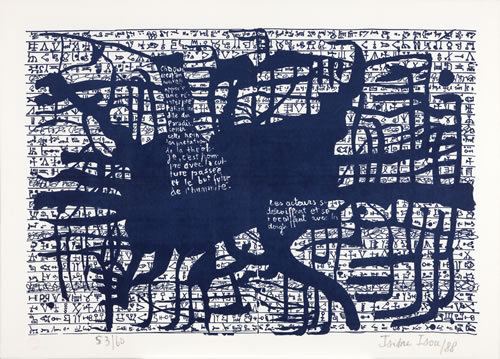Name Isidore Isou Role Poet | Movies Venom and Eternity | |
 | ||
Died July 28, 2007, Paris, France Albums Poemes Lettristes 1944-1999 Similar People Marc'o, Marcel Achard, Jean‑Louis Barrault, Blanchette Brunoy, Blaise Cendrars | ||
Orson welles interview featuring isidore isou lettrism
Isidore Isou ([izu]; 29 January 1925 – 28 July 2007), born Ioan-Isidor Goldstein, was a Romanian-born French poet, film critic and visual artist. He was the founder of Lettrism, an art and literary movement which owed inspiration to Dada and Surrealism.
Contents
- Orson welles interview featuring isidore isou lettrism
- Isidore isou 1925 2007
- Biography
- Published works
- References

Isidore isou 1925 2007
Biography

Born into a Jewish family in Botoşani, Isou started his career as an avant-garde art journalist during World War II, shortly after the 23 August coup saw Romania joining the Allies (see Romania during World War II). With the future social psychologist Serge Moscovici, he founded the magazine Da, which was soon after closed down by the authorities. He moved to Paris, having developed many concepts that intended a total artistic renewal starting from the most basic elements of writing and visual communication. He adopted then the French first name "Jean" (John in English) and the pseudonym "Isidore Isou". He called himself a Lettriste, a movement of which he was initially the only member (at the age of 16 he had published the Manifesto in 1942) and published a system of Lettrist hypergraphics. Others soon joined him, and the movement continues to grow, albeit at times under a confusing number of different names.

In 1951 the young Isou released his experimental and revolutionary film Traité de bave et d'éternité (Treatise on Venom And Eternity), work deemed revolting by many critics present at the premiere. Including a reflexive discourse on the making of a new cinema, it became a virtual Lettriste film manifesto. Attacking many film conventions by chiseling away at them in his film, Isou introduced the concept of "discrepancy cinema" where the sound track has little or nothing to do with the accompanying images. The sound track of Treatise on Venom and Eternity begins with jarring and unpleasant human noises, which continue in low volume throughout the spoken dialogue. In addition, the celluloid on which the film was recorded was attacked with destructive techniques such as scratches and bleaching. The film caused a scandal at the 1951 Cannes Film Festival, and was later introduced into the United States, where it influenced avant-garde film makers such as Stan Brakhage. In the early fifties one segment of Orson Welles' film journal, which was entitled Le Letrrisme est la Poesie en Vogue, included an interview with Isou and Maurice Lemaitre.

In the 1960s Lettrist, Lettrist-influenced works and Isidore Isou gained a great deal of respect in France. The influential writer Guy Debord the artist Gil J. Wolman and the writer and artist Gabriel Pomerand worked with Isou. Debord and Wolman later broke away to form the Lettrist International, which later merged with the International Movement for an Imaginist Bauhaus, and the London Psychogeographical Association to form the Situationist International, a dissident revolutionary group. In this new form using means acquired over the course of a decade prior, Lettrist art exerted a profound influence upon the posters, barricades, even designs for clothing in the attempted revolution of 1968. Although it had seemed a highly self-contained art in the post-war period, in 1968 it became more deeply involved in active social change than such movements as Existentialism and Surrealism, and came closer to producing actual transformation than these movements.
Isou's final public appearance was at the University of Paris on 21 October 2000, aged 82. Crippled by ill health, he remained house-bound until his death in 2007. Many of his works, and those of the other Lettrists, have recently been reprinted in new editions, together with much hitherto unpublished material, most notably Isou's extensive (1,390 pages) La Créatique ou la Novatique (1941-1976). In July 2007, Kino International released a DVD collection Avant-garde (dvd collection)|Avant-Garde 2: Experimental Films 1928-1954, which included Isou's film Traité de Bave et d'Èternité (Venom and Eternity) (1951).
